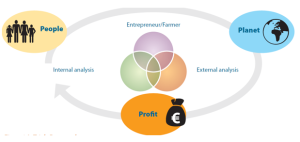Interactive Strategic Management Method (the ISM method)
All of the mentioned changes are providing farmers with new challenges. Based on experience in several projects, LEI Wageningen UR has developed a method to support farmers with strategy development: Interactive Strategic Management (ISM). ISM has three main principles:
(1) the emphasis on the entrepreneur;
(2) interaction with the environment; and
(3) focus on actual progress or actions of the entrepreneur.
Emphasis on the entrepreneur
Placing the entrepreneur at the centre means that, instead of an advisor, the farmer himself is responsible for the content of the strategic plan. The entrepreneur must therefore write the strategic plan himself; an advisor is only there to guide and stimulate the process. In an ISM track, entrepreneurs are challenged to thoroughly examine their business, the environment and themselves; for example, by analysing the current business performance. Because the ISM track almost always takes place in group situations, the entrepreneur can also make use of the expertise and feedback of his colleagues.
The intention is that the entrepreneur intensely experiences the entire process and simultaneously develops the competencies needed for the future of his business. You could say that the approach focuses on empowering the entrepreneur.

The entrepreneur is at the centre of the ISM process
Interaction with the farm environment
While the entrepreneur may be central in Interactive Strategic Management, he is by no means isolated. In modern society, agrarian businesses cannot be seen as an isolated link in the food chain. Depending on the proposed strategy of the entrepreneur, he must enter into a dialogue with his environment: with his neighbours concerning plans for expansion, for example, or with (new) supply chain partners, colleagues or nature and environmental organisations.
The roll of an advisor or coach is to challenge the entrepreneur to include developments in his direct environment or in broader society into his strategy and to involve them in his plans. This prevents the tendency some entrepreneurs have of setting themselves apart from the community or from new developments in the market or society in general. Because the entrepreneur is part of the community he must gain more insights and learn how to deal with situations pro-actively. Strategic decision making is, after all, about more than simply choosing the best technical/economic long-term direction for the business. It is also about legitimising the business (Schans, van der, 2008).
The focus on the process is not so much on technical issues, but more on the person(s) and neighbourhood involved and the society (People), the environment (Planet) and economics (Profit). We say the focus is on a triple P (3xP). This is illustrated in Figure 1.

Focus on actions of the entrepreneur
Interactive Strategic Management is intended more to set entrepreneurs in motion than to transfer (theoretical) knowledge. The core of the ISM approach is therefore not so much to arrive at a total objective image of the entrepreneur, his business and environment but to generate so much energy and confidence that the entrepreneur can take (solid and well-founded) steps forward. It is about simultaneously thinking and doing. Apart from that, it is necessary that the entrepreneur forms the most realistic image of his possibilities as he can in order to make good plans. The interactive approach of ISM is pre-eminently suited to bringing ideas into focus (Schans, van der, 2008). Each ISM track ends with a SMART action plan.







